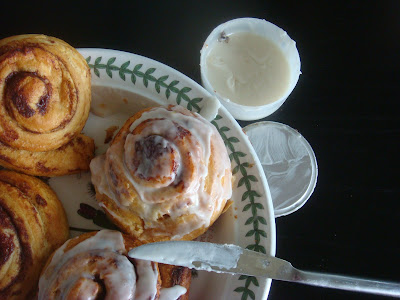 I have enormous vegetable love. Really. In fact, I'd like to have a scarf that looks like this picture of rainbow chard stalks (Peter Max would be my designer). I find giant fast food chains repellent and what they've turned all of us into tragic. I wish every other corner in every urban wasteland had a vegetable garden instead of a McD. While I eat cheeseburgers (and not just good cheeseburgers; I'll eat the crummy one, too), and display other frankly carnivorous habits, I think it is extremely important that we all learn to eat a lot less meat. I believe that if the world does not start cooking more, it is lost. O, lost. But I sure do wish there were a lot more good restaurants in my neighborhood. Do I contradict myself? Very well then.
I have enormous vegetable love. Really. In fact, I'd like to have a scarf that looks like this picture of rainbow chard stalks (Peter Max would be my designer). I find giant fast food chains repellent and what they've turned all of us into tragic. I wish every other corner in every urban wasteland had a vegetable garden instead of a McD. While I eat cheeseburgers (and not just good cheeseburgers; I'll eat the crummy one, too), and display other frankly carnivorous habits, I think it is extremely important that we all learn to eat a lot less meat. I believe that if the world does not start cooking more, it is lost. O, lost. But I sure do wish there were a lot more good restaurants in my neighborhood. Do I contradict myself? Very well then.
Anyway, against my better judgment and in spite of the fact that I believe myself to be a kind person at heart, it seems that I have tended to make fun of vegetarians, even though I expect them not to make fun of me.
Which I didn't even realize until I started cooking so often from Peter Berley's really terrific vegetarian cookbook Fresh Food Fast (Regan Books, $34.95). Berley--who, also, is not a vegetarian per se--is the former chef at the wonderful East Village cafe, Angelica Kitchen, a place I used to visit pretty frequently when I lived in NYC.
The night before last, I made a delicious soup from his book, using some ethereally pretty purple turnips, the deep green leafy tops of the rainbow chard, leeks, and some tiny white potatoes. It was so dreamy (especially since it contained an added, gigantic glug of cream in my version as well as the addition of some leftover crushed potatoes to thicken it) that I went to the Angelica Kitchen site and took a skip down memory lane.
There I found a review I wrote about Angelica Kitchen, back when I edited Tables for Two at the New Yorker magazine. I didn't remember writing it until that moment; the piece is that old (from a quainter time, before everyone signed their pieces, so maybe 95? 96).
The point being: I now feel like a bit of a dolt. I seemed smug, depicting the place as a kind of hippie throwback; if you look at the Angelica Kitchen site today, you'll find the place seems incredibly modern. And who could not love a place that serves a Wee Dragon Bowl? So, here, hangdog, and so many years later, I apologize for my tone, especially since I really liked the food.
Post-Angelica, Berley and his new book seem even more modern. (Caramelized bananas with blood orange and pistachio, giant arepas with aged Gouda, warm mesclun salad with sherry vinaigrette and five-minute eggs.) Fresh Food Fast has its share of wheat-heady recipes that I know I won't make (tofu, yes! seitan: hell no), and it was upsetting to realize a pressure cooker is required for quite a few of the recipes. But it is otherwise a great example of how terrifically creative and satisfying vegetarian home cooking can be.
Now, you're probably wondering where the turnip soup recipe is. (Saunders ate 3 bowls in one night, and the next night she asked very politely if I we could make my version of another dish from the book, a spicy sweet potato, kale, and coconut milk stew, served with rice. So that's here, too.)
Leek and Turnip Soup with Potatoes and Chard, adapted from Fresh Food Fast, by Peter Berley
Serves 4-6
3 tablespoons butter
2 large leeks, white and tender green parts, cleaned, cut lengthwise, and sliced into 1/2 inch thick pieces
1 teaspoon coarse sea salt
4 cloves garlic, chopped
1 tablespoon caraway seeds (don't overdo it)
2 pounds small turnips, peeled if necessary, cut into 3/4 inch pieces
1 pound small red or yukon gold potatoes, cut into 1-inch pieces
1 bunch of Swiss chard, trimmed and leaves roughly chopped
Freshly ground black pepper
1/2 cup cream or half and half or 1 cup milk
Optional: Any leftover mashed or crushed potatoes you have. I used about 2 cups.
- Melt butter in a large saucepan or Dutch oven over medium heat. Add leeks, a pinch of the salt, and saute until soft, about 5 minutes. Add garlic, caraway seeds; saute for 3 minutes.
- Add 6 cups of water, turnips, potatoes; bring to a boil over high heat. Add remaining salt, reduce heat to medium, and simmer, covered, until vegetables are tender, about 15-20 minutes.
- Add chard and simmer until wilted, about five minutes. If a thicker soup is desired, use a potato masher a few times, right in the pot of soup.
- Optinal: Add leftover mashed potatoes if you have them. Simmer 5 more minutes until heated through.
- Lower heat, slowly stir in cream or milk if you'd like. Adjust salt and pepper to taste; a lot of pepper is really good with turnips, FYI.
Spicy Coconut Sweet Potato Stew with Kale, adapted from Fresh Food Fast
Serves 4

With the coconut milk (which makes everything wonderful, but has 900 calories in a 14-ounce can, like some kind of crazy tropical lard), not to mention jalapeno and lime, this stew puts you in a trance. You can't stop eating it. Substitute light coconut milk with little ill effect.
2 tablespoons olive oil
2 cups diced onion (2 medium)
2 teaspoons coarse sea salt, or more to taste
2 large sweet potatoes, peeled, cut into 1 inch chunks (about 5 cups)
4 cloves garlic, finely chopped
1 jalapeno pepper, with seeds, minced
1 tablespoon minced fresh ginger
1 teaspoon coriander seeds, toasted and ground, or 1 teaspoon ground coriander
1/2 teaspoon turmeric
1 (14 ounce) can coconut milk
1 bunch kale, stems removed, roughly chopped
1 lime cut into wedges
1/2 cup chopped cilantro, for garnish
- Heat oil over medium in a large saucepan. Add onion, pinch of salt; saute until softened, about 5 minutes.
- Add sweet potato, garlic, jalapeno, ginger, coriander, turmeric; saute for 5 minutes. Add 3 cups water, coconut milk, remaining salt; raise heat, bring to boil. Reduce heat and simmer, covered, 15 minutes.
- Add kale; cover and simmer until kale is tender, about 10 minutes. If too soupy, continue to simmer until thickened. Taste for salt and pepper. Serve with a large spoonful of jasmine rice, garnished with cilantro and lime slices.













